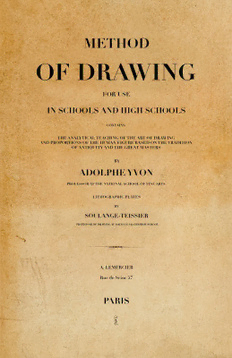Table Of ContentThis book presents the complete English translation of
Professor Adolphe Yvon’s book, Méthode de Dessin (1867).
The translation credit goes to numerous individuals around
the world who participated in the project in response to a
request I made on my blog. I have edited their translations,
on occasion, in keeping with contemporary language and
the context of the book.* Like the original, this translation
is now in the public domain. You may use it in any way you
wish. No credit to me is necessary.
The original book is tabloid size and I have therefore sized
this PDF similarly. This will allow readers to see the plates as
close to the original size and quality as possible.
At the time of publication, the original scans are
available through various posts on my blog:
studiorousar.com/category/instruction/methode-de-dessin/
Thanks to all who helped out!
Darren R. Rousar
2014
* Note that I have not translated anatomical names.
Method of Drawing
by Adolphe Yvon
Forward
The goal of teaching drawing in the high schools and colleges is to put students in
the position of applying and developing, later in their careers, the knowledge that
they have acquired in this interesting branch of their studies.
It is to satisfy these conditions that the Government schools require drawing, to a
certain degree, for the admission of their prospective students.
However, one could not reach this goal simply by copying skillfully made
crosshatched prints without learning the fundamentals which underlie the laws
of drawing. It is also to be feared that the direction of one’s ideas would become
distorted or sent down the wrong path by such work, as is often the case when
the student succeeds in such endeavors early on.
On the other hand, studying high aesthetics and applying its concerns to sort and
suggest, using the great works of the masters as models, is surely premature.
In fact, some opinions do not support such models, whose infinite diversity still
troubles artists even after a whole career dedicated to the search for Truth and
Beauty!
What is needed is a clear and logical method of teaching which provides young
people with the means to understand and apply the elementary problems of the
art of drawing.
The foundation of this teaching will be an intimate knowledge of the principle
geometric figures, such as the vertical line, the horizontal, the oblique at all angles,
the circle, the oval, etc. — All forms are nothing but a succession of these figures.
However, it would be dangerous to push to excess this reduction of forms, and
especially human forms, to geometric shapes. The difficulty of such operations
are likely to repel rather than help the students in their studies.
It would also be a mistake to believe in the discovery of a method for teaching
drawing, based solely on observation, in only a few lessons.
Continuous, serious study is the only way of learning the principles of art in which
mathematical formulas are relevant only to a small degree and then solely as a
support.
The method that should be followed for drawing, either from life or from references,
consists in positioning what we want to achieve by the means of simple lines,
whose carefully thought-out angles (compared to the vertical and the horizontal)
first give the general directions of movement. The vertical and horizontal lines
must be drawn before anything else, to serve as guides, as can be seen from the
examples in this book.
Once these lines are in position, the student will then use them as a basis to
consider the principal divisions of length and width. A student cannot be too
careful with this preparatory work: the success of his drawing will depend on it.
It is evident, clearly, that if these principal lines and proportions are correct, the
rest will be nothing but a question of details; and these, even if clumsily done, will
not be able to take away from the overall character and fidelity of the drawing.
The references used, especially in beginning lessons, should as much as possible
be accompanied by the main divisions and reference marks which will facilitate
copying.
In the more advanced classes, it will be a good idea to vary the references by
adding draped or clothed figures, groups, etc.
The diagrams on the following pages show examples at different stages of
development:
-The placement, with the main divisions
-The refined contour
-The values
To draw the human figure, it is essential to have knowledge of certain proportions
or ratios of common lengths and widths.
Almost all masters created for themselves a scale of proportions (which we call
a “canon”), applied to the human figure. Among the most famous we can cite
Albrecht Dürer and Leonardo da Vinci.
We could not do better than to be inspired by such predecessors. However, for
the studies which we are setting for ourselves, these scales are, for the most part,
overloaded with complications. It will be necessary only to extract from them the
principal rules.
We have thought it useful to complete this book by giving the écorché and skeleton
of the two male figures contained within. Knowledge of bones and surface anatomy
is invaluable in understanding the human form.
Before finishing this introduction, we cannot overemphasize that you should draw
as much as possible, either from live models, casts, or any inanimate objects. The
problems are invariably the same, regardless of the source. They demand above
all, a laborious and constant education of the eye: once acquired, the hand will
soon become an instrument, if not always dexterous, at least relatively accurate.

